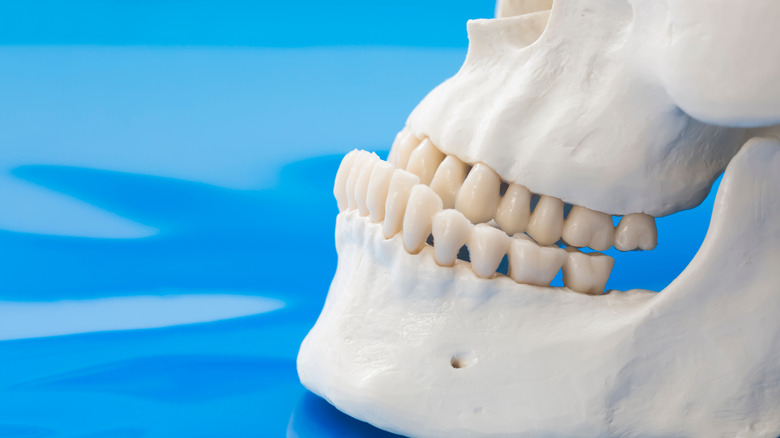Research Shows This Facial Feature Found In Royal Family May Be Due To Inbreeding
A recent study has shed light on the infamous "Habsburg jaw," the facial feature found in many members of the Habsburg royal family. The research, published in the journal Annals of Human Biology, suggests that this distinctive jaw may have been the result of inbreeding. The Habsburgs were a German-Austrian governing family whose influence extended from Portugal to Transylvania (via Smithsonian Magazine). The Habsburgs strategically wed, frequently to close relatives, to increase their influence. Despite the dynasty's immense wealth and magnificent residences, the monarchs themselves were not blessed with beauty. Many generations of Habsburg kings and queens had protruding jaws, long noses, and bulging lower lips. These features combined create the "Habsburg jaw."
The study, conducted by geneticist Román Vilas of the University of Santiago de Compostela in Spain, focused on 15 individuals who were believed to be Spanish Habsburgs. The Spanish Habsburgs ruled Spain for two centuries until the death in 1700 of the 38-year-old Charles II. To find the study subjects, researchers looked at photorealistic portraits of Spanish Habsburgs spanning 20-plus generations.
It appears inbreeding was a common practice in the family
The researchers found that the average inbreeding coefficient of the Habsburgs they studied was .093. According to National Geographic, this indicates that about 9 percent of a certain royal's matching genes (one maternal, one paternal) were the same since they descended from the same progenitor. The researchers also recruited mouth and jaw surgeons to examine the photos and count how many facial characteristics typical of conditions like a protruding jaw and sunken midface there were on each Habsburg descendant. The higher the score, the more dysmorphic traits were present.
Researchers discovered that people with high scores, and the "Habsburg jaw" feature, tended to have a high inbreeding coefficient. Among the Habsburgs examined, variations in inbreeding levels were responsible for 22 percent of the variations in the severity of protruding jaws. Philip IV, Charles I, and Charles II each had more physical features indicating inbreeding than any other family member. Although Charles I had an inbreeding coefficient of .038, which was very low for his family, the genetic effects of inbreeding became more prominent with later generations. Based on the data, researchers hypothesize that the "Habsburg jaw" was generated by a recessive gene. Due to the fact that recessive traits are only statistically more likely to appear when both of an individual's two copies of each gene are identical, these genes are more likely to be passed on when inbreeding is common in families.
Other effects of inbreeding on the Habsburg royal family
The "Habsburg jaw" wasn't the only effect seen on Habsburgs who were inbred. According to National Geographic, Charles II of Spain suffered various physical and mental disabilities due to inbreeding. He was bald by the time he was 35, had a huge tongue that made his speech difficult to comprehend, and passed away senile and tortured by epileptic episodes. He was also impotent, and as such, was unable to produce an heir to his throne.
Historians believe that these health issues were likely caused by one of two potential recessive genes that were passed to Charles II. The first condition is a combined pituitary hormone deficiency, which is brought on by changes in the PROP1 gene. The condition, which affects one in 8,000 people, is brought on by the pituitary gland's failure to produce critical hormones. It is often associated with small stature, lack of interest in surroundings, infertility, and digestive issues. Distal renal tubular acidosis, the second possible condition, is brought on by mutations in the genes ATP6V0A4 and ATP6V1B1. This condition interferes with the kidneys' capacity to eliminate acid through urine, which can result in red urine, rickets, weak muscles, and an abnormally large head. Inbreeding also affects previous attempts at heirs within the Spanish Habsburg family: half of the 34 children born died before their tenth birthday.
The health dangers of inbreeding
Inbreeding and incest are monitored and/or illegal in many parts of the United States (via Criminal Defense Lawyer). While emotional trauma is a factor, there are also health concerns that play a part. According to BBC Earth, children born of incest are more likely to experience genetic defects as well as a host of other health problems. Some of these include a low birth weight, slow growth, and an increased chance for various birth defects. Other issues may include heart defects, mental illness, and problems with vision or hearing. Children of incestuous relationships are also more likely to suffer from genetic disorders, such as cystic fibrosis or muscular dystrophy.
Incest can also cause severe psychological damage, especially when it involves an unequal power dynamic, such as a father and a daughter (via The Canadian Journal of Psychiatry). This can lead to feelings of guilt, shame, and isolation. In some cases, it can also result in post-traumatic stress disorder. While the Habsburgs are an extreme example of the effects of inbreeding, they serve as a reminder of the potential dangers of incestuous relationships.




